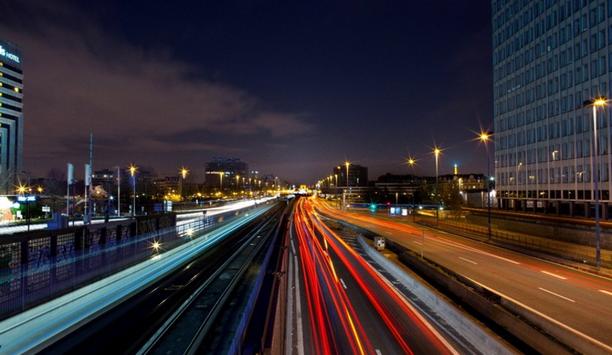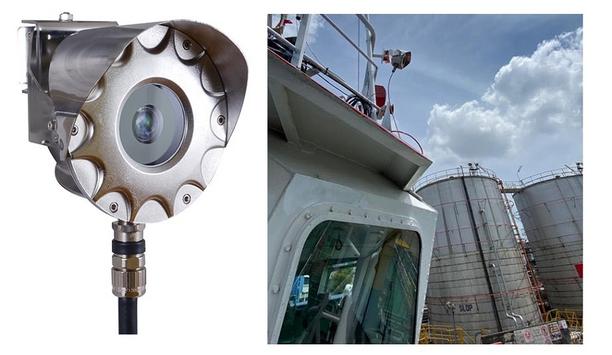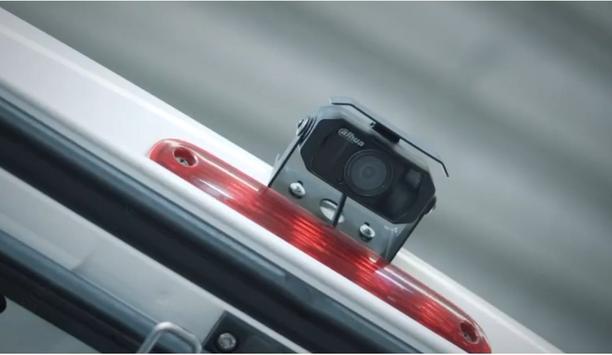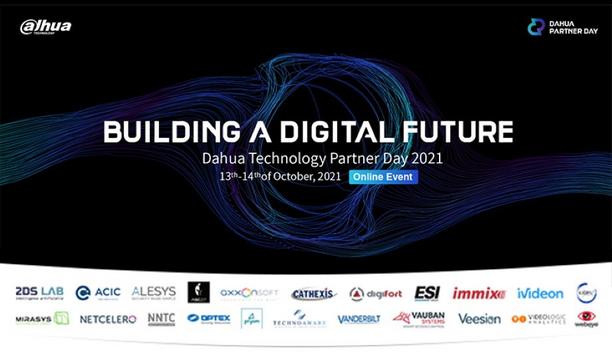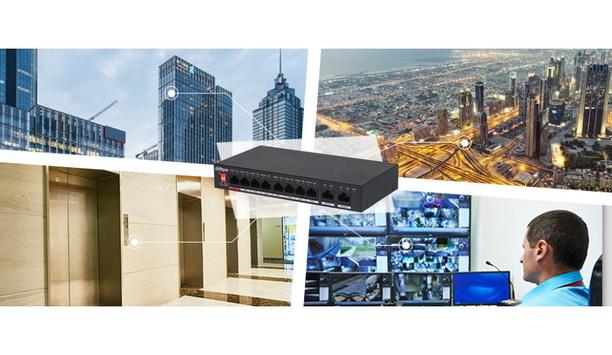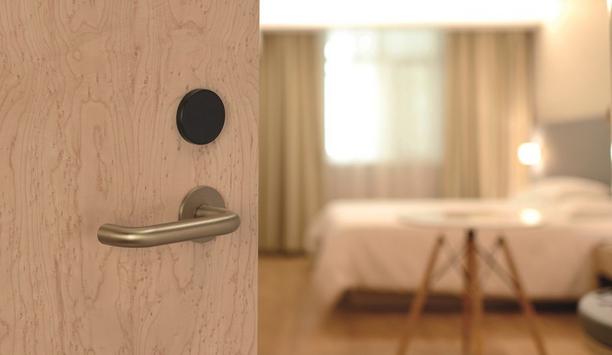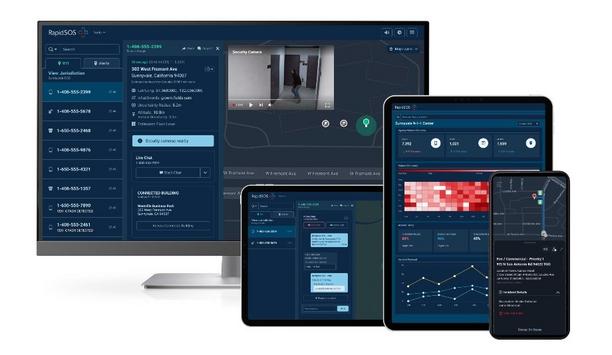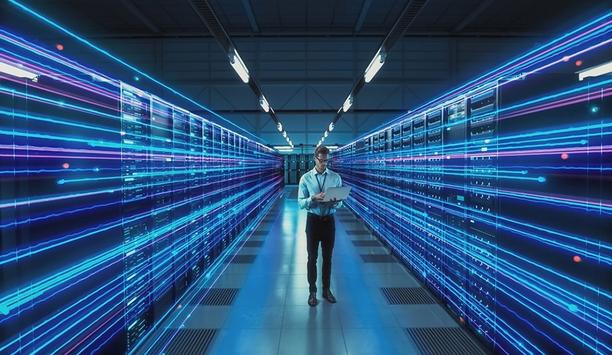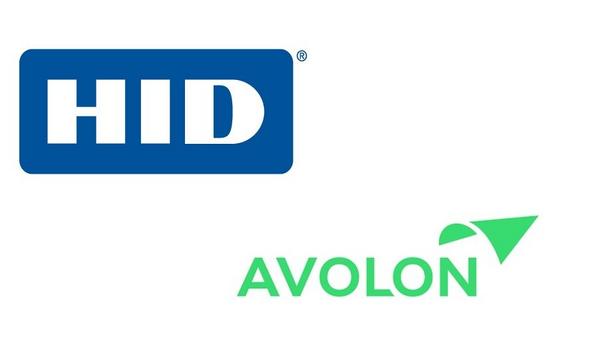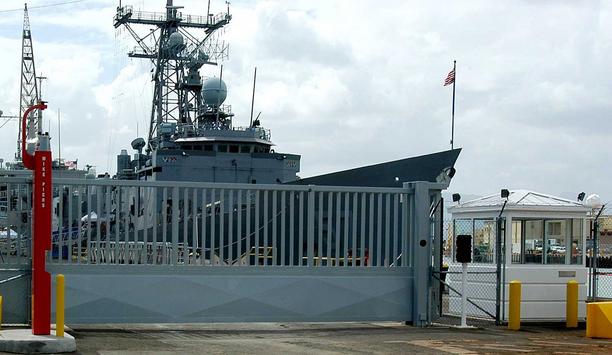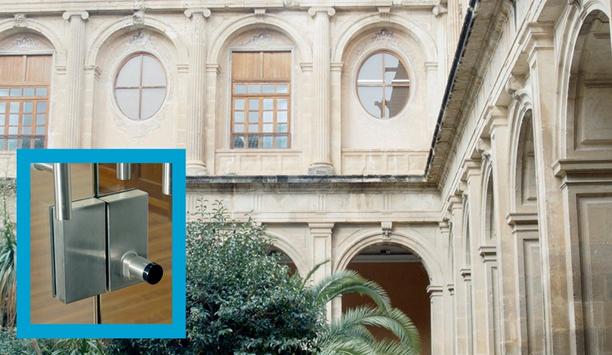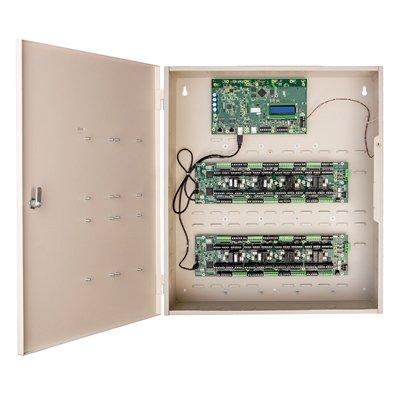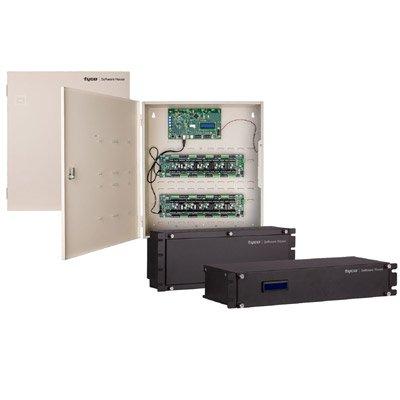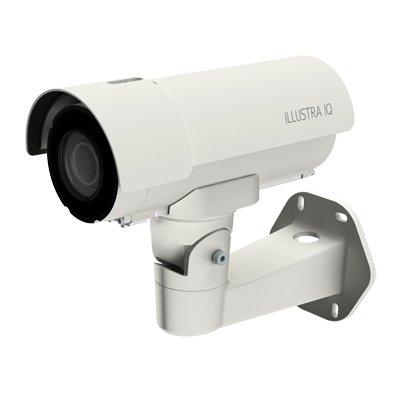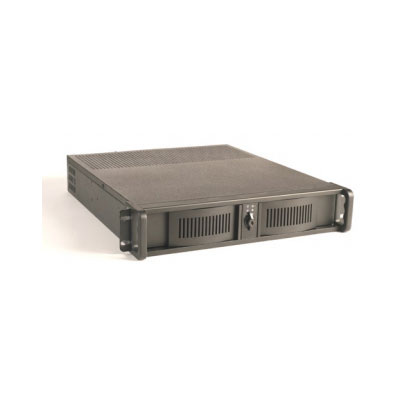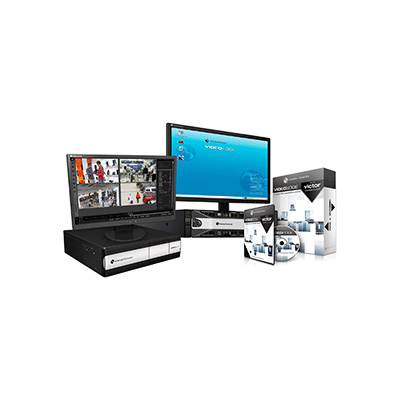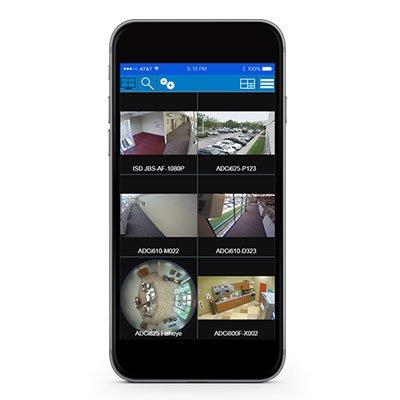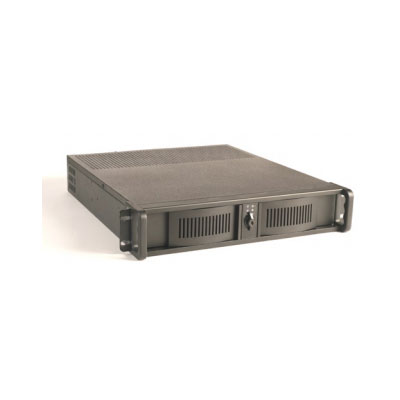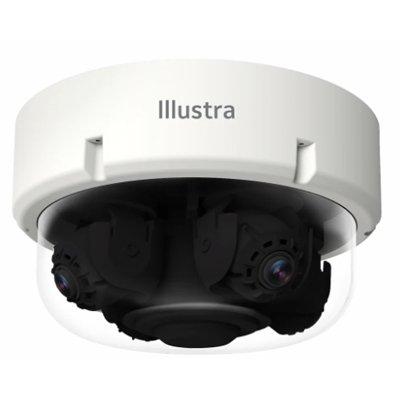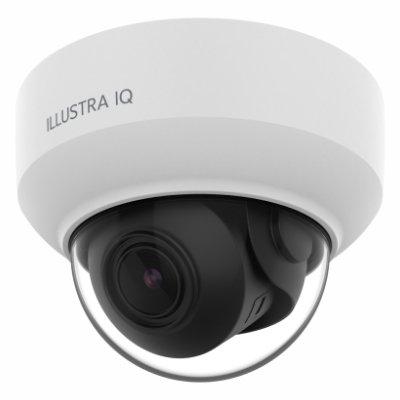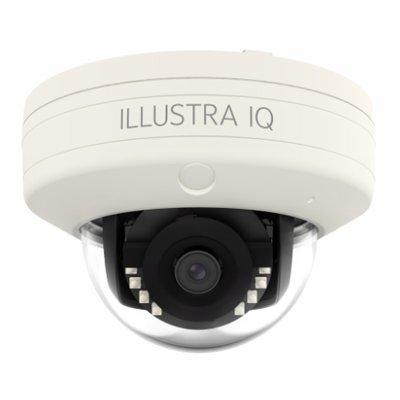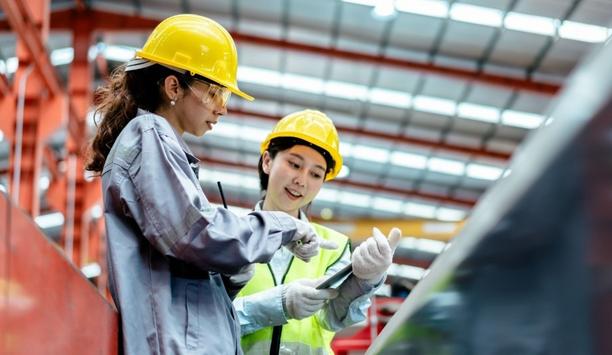Transportation security applications
The Swiss Federal Railways (SBB) is the largest rail and transport company in Switzerland with 1.2 million passengers and 180,000 tonnes of freight transported every day. SBB is a pioneering rail system in Europe due to its quality of service, safety, and reliability. It operates passenger, cargo, and freight services, with large real estate holdings across Switzerland that it needs to keep secure and protect from crime, anti-social behavior, and trespassing. High-performance cameras S...
The city of Neuilly-sur-Seine, in France, is home to Avenue Charles-de-Gaulle (RN13), an urban expressway, which is frequented by approximately 130,000 vehicles per day - from small cars to large buses and trucks. The avenue serves as a connection from Paris to the business district of La Defense, and is one of the busiest motorways in France. To get this avenue to keep on thriving, the municipality, in 2019, started a major modernization project called ‘Les Allées de Neuilly&rsquo...
The NOC fleet counts about ten oil products tankers sailing in the Singapore area. These vessels carry highly flammable fuel oil waste for proper recycling or disposal treatment. The client needed to equip three vessels of the fleet with a reliable onboard video surveillance system that was explosion-proof certificated given the presence of an explosive atmosphere. After various researches, the client decided to employ the MAXIMUS MMX stainless steel cameras for the video surveillance...
Aerocharter is a provider of technical, operational, and commercial services to support aviation. Its main activities are cargo services, including handling, storage and supervision of cargo, in parking apron and warehouse. In addition to ramp operations with loading and unloading options, Aerocharter also provides services in aircraft movement, cargo insurance, and security, line maintenance, among others. Video security with AI technology To strengthen its state-of-the-art services, Aerocha...
The cloud-based access control and video management system was recently installed at the city’s marina where it has integrated with their booking system, Harba. Harba booking system There are 750 members with boats in the Vejle marina, and through the Harba booking system; they are issued a 6-digit personal PIN code or a tag. With this PIN code, they can then access and use the facilities of the marina, such as the toilets, showers, laundry rooms, and kitchen. The PIN is inputted into t...
Dahua Technology, a globally renowned video-centric smart IoT solutions and service provider, will hold its 2nd online Dahua Technology Partner Day, from October 13 - 14, 2021, with the theme - ‘Building a digital future’. Dahua Technology Partner Day Adhering to its strategy of open cooperation, Dahua Technology is committed to creating a win-win ecosystem, with major technology partners around the world. This year, Dahua Technology will join hands with its 22 global partners, in...
News
Remote e-signature specialist, Cryptomathic, has partnered with fidentity, an expert in online identity verification, to enable automated identity verification for qualified remote e-signing-the highest level of assurance under European and Swiss law. Under the European Union’s eIDAS and Switzerland’s ZertES regulations, remote (QES) provide the highest possible level of security and non-repudiation in e-signature services. To perform a QES, the signer’s identity must first be verified. Until now, this has only been possible via cumbersome and slow manual processes in which physical identity documentation, like a passport, is presented and verified either in-person or via a live video call. Such processes reduce the utility of the remote e-signing model and have been a barrier to widespread QES adoption across the two regions. Cryptomathic and fidentity’s partnership Cryptomathic and fidentity’s partnership aims to address this problem head-on, by integrating an automated, digitized, and legally compliant identity verification process into the remote QES signing experience. Thorsten Hau, Founder of fidentity said: “As an expert in digitized and automated online identity verification, fidentity is providing the last piece in the puzzle that will enable remote Qualified Electronic Signatures to become accessible to all. By partnering with Cryptomathic, our intent is to marry the two services together to dramatically enhance the end-to-end signing experience for both providers and end-users, which ultimately will accelerate the uptake of this brilliant enabling technology. A smartphone, a valid ID document and a smile is all it will take to complete a legally binding signature.” Author's quote Cryptomathic and fidentity’s partnership aims to digitize and legally compliant identity verification process Guillaume Forget, EVP e-Signature and Mobile Security at Cryptomathic said: “The provision of accessible, secure, and legally binding remote e-signatures services is crucial to the future of digital transformation. While remote Qualified Electronic Signatures answer this need by delivering maximum security and a high level of legal assurance, the process of obtaining the verified identities required to perform the signature has remained cumbersome and off-putting." He adds, "By uniting fidentity’s digitized and legally assured user experience for identity verification with Cryptomathic’s industry-leading Signer solution, we hope to enable faster and more widespread adoption of highly secure remote e-signatures across Europe and Switzerland.” Cryptomathic’s pioneering e-signature solution The partnership will bring together Cryptomathic’s pioneering e-signature solution, Signer, and fidentity’s KPMG-certified identity verification interface, IDENT. Signer is one of the elite few certified remote Qualified Signature Creation Devices available across EU and Swiss jurisdictions. fidentity delivers a seamless online identity verification service, powered by automation and operating in full compliance with the latest Financial Market Supervisory Authority (FINMA), European Telecommunications Standards Institute (ETSI), and eIDAS requirements.
More than one million electric vehicles are registered in the U.S.—and they all have to plug in somewhere. As EV charging stations pop up across the country, one of the chief questions will be how charging station users are identified, authenticated, and connected with membership or payment systems. Radio-frequency identification cards and tokens and smartphone authentication apps have emerged as two viable options for EV charging authentication. Which is best? It may depend on the user base they plan to serve. User authentication for EV charging Most electric vehicle owners have a spot to plug in while at home, either in their own garage or carport or in a designated charging spot in a tenant parking garage. But electric vehicles also need spots to charge while owners are out and about. The EV charging market is broadly divided into two tiers: Level 2 charging stations, which operate at 208-240 V and use AC power. These stations will add 20-25 miles of range in about an hour of charging. The U.S. Department of Transportation listed more than 22,800 public Level 2 EV charging stations across the nation as of mid-2020. They are commonly found in public parking lots and garages, hotels, grocery stores, malls, and other commercial areas. They may also be installed in private parking garages and business parking lots for use by tenants, employees or fleet drivers. Collecting membership data Direct Current Fast Chargers (DCFS) are designed to charge an EV battery to about 80% in 20-30 minutes. There are currently about 15,000 DCFC stations across the U.S., but their numbers are expected to explode as more people start taking EVs on longer road trips. They are commonly found along major interstate highways. As the market evolves, user authentication requirements for EV charging stations are likely to vary by type, location, and user base. Some commercial locations may provide Level 2 EV charging as a free amenity to shoppers, guests or employees. If there is no charge for the service, there may be no need to authenticate users at all— people can simply park and plug at any available spot. However, there may be a benefit to collecting membership data (e.g., shopper reward club). Private charging stations Public, for-profit EV charging stations, like gas stations, need a method to collect payment for their services. In some cases (especially at roadside DCFS stations), users may simply pay for the minutes used with a credit card—just like at the gas station pump. However, many EV charging station users are already accustomed to identifying themselves with an RFID membership card or a smartphone app. Charging networks like ChargePoint and Blink enable members to access any EV charging station within their networks with a card or smartphone app, which connects to their membership, account, and payment information. Private charging stations—such as those offered to tenants, employees or fleet drivers—may not require payment but need to ensure that only authorized drivers are accessing power and taking up valuable parking spots. An RFID card or smartphone app can be used to identify authorized drivers and track charging behaviors. Moving forward, many EV charging stations may find that they need a mix of options for users, including membership cards, smartphone apps, and a credit card payment option for out-of-network drivers. Choosing between RFID and smartphone apps In the long run, the answer may be ‘both.’ RFID cards are economical and easy to issue When user identification and authentication are desirable, which is the better option: RFID cards or smartphone authentication? Both have their uses in the EV charging market. In the long run, the answer may be ‘both.’ RFID cards are economical and easy to issue. And for some users bases, they may not have to issue a new card at all—they can take advantage of an RFID card they already carry. In many cases, it is possible to leverage existing employee IDs and membership cards for access to privately controlled EV charging stations. RFID membership cards may be a good bet for: Fleet drivers who already carry an RFID card for vehicle access. Employee parking lots and garages where people already use a card for entry. EV charging parking spots at gyms or other locations where users want to limit charging access to active members. EV charging stations Most consumers would prefer not to have to carry a physical membership card for every retail outlet On the other hand, public charging stations may find that consumers would prefer to use a smartphone app rather than receive another membership card to carry in a physical wallet. Many consumers prefer to carry only their phone and one or two essential cards (such as a driver’s license and a single credit or debit card). As more retailers enable consumers to pay via a digital wallet app on their smartphones, some don’t even carry a physical credit card anymore. Most consumers would prefer not to have to carry a physical membership card for every retail outlet they visit—and that includes EV charging stations. Smartphone apps for user authentication are simple to set up and highly secure. Instead of RFID, they typically use either Bluetooth® Low Energy (BLE) or Near-field Communication (NFC) protocols. Public charging stations For the user, the experience is almost identical to RFID authentication, except they wave a smartphone over the reader instead of a card. Apps have other user benefits, too. A custom app for EV charging can be configured to help users locate or reserve charging stations, check their balance and usage history, and change their payment options right on their phone. These features make smartphone authentication ideal for consumers These features make smartphone authentication ideal for consumers accessing a network of public charging stations. However, EV charging network managers should keep in mind that some users may still want a physical membership card. Smartphone-Based authentication There are still some user populations, such as older consumers and those from lower income brackets, where smartphone ownership is not ubiquitous. If users are primarily using EV charging for a fleet vehicle, they may not want to download an application for work on their personal cell phone. Other users may find smartphone apps confusing or simply prefer to have a card for other reasons. The answer for both public EV charging networks and private charging station owners is to have an RFID reader that is capable of both card-based and smartphone-based authentication. This will provide maximum flexibility as user preferences change. Finding the right RFID reader for EV charging The ELATEC TWN4 MultiTech family of readers is ideal for authentication at EV charging stations The best RFID reader for EV charging is one that is flexible enough to meet the needs of all user populations and evolve as requirements change. The ELATEC TWN4 MultiTech family of readers is ideal for authentication at EV charging stations. The readers support 60+ RFID transponder technologies along with BLE and NFC smartphone authentication. This means that one reader can support all common technologies already in use across the entire user base—both nationally and internationally. This capability becomes important for applications where users want to enable drivers to use an existing RFID card (such as their employee or fleet ID card or an access card for a tenant parking garage) for access to charging locations. It also provides more flexibility as technologies or preferences change in the future. Supporting advanced encryption TWN4 MultiTech supports advanced encryption and security configurations for highly secure transactions between the card or smartphone and the reader. This is important for EV charging applications tied to payment or employee/driver identification. ELATEC readers are mobile-ready. The ELATEC Mobile Badge BLE NFC App offers simple and effective components for building or extending a mobile application for EV charging networks. Non-managed mobile credentialing using the ELATEC app is free. TWN4 MultiTech readers also work with multiple existing third-party managed credential systems, such as KleverKey, Safetrust, and Transact. The TWN4 MultiTech is easy to customize with the powerful Software Development Kit (DevPack) and App Blaster and Director utilities. Readers can be easily configured to support custom functionality (such as LED light flashing sequences or sounds for user feedback) and integration with backend software for easier member management. The DevPack tools make the TWN4 family the most powerful, versatile, and sustainable readers on the market. Hardware communication interfaces As electric vehicles move from niche to mainstream, EV charging infrastructure will need to grow and evolve to accommodate millions more drivers—both in the consumer market and in commercial fleets. With TWN4 MultiTech, EV charging station managers will be ready. Interested in learning more about technical considerations for RFID? Download 11 Considerations for Embedded System RFID Readers for additional advice, including operating power and consumption requirements, antenna placement, hardware communication interfaces, and more.
International aerospace, defense, and security company Leonardo is exhibiting at Singapore Airshow 2022 (15-18 February, stand B-H39), presenting its electronics, aircraft, helicopters, and cyber security capabilities and technological solutions to customers from the Indo-Pacific, a strategic region for Leonardo, and beyond. BeTomorrow2030 plan Leonardo has a strong presence in Singapore with its representative office and subsidiary and considers the Government of Singapore to be a particularly notable customer. Across the region, Leonardo is keen to reinforce existing alliances and develop new ones, with the company’s network of international partnerships a key part of its BeTomorrow2030 strategic plan. Leonardo Lab Via Leonardo Lab, hubs dedicated to leading-edge and breakthrough technologies Leonardo is a pioneer in innovation and is driving technologies that will benefit the lives of people around the world through continuous and directed investment in research & development, as well as via Leonardo Lab, hubs dedicated to leading-edge and breakthrough technologies. Delegations from the Indo-Pacific region and beyond, where Leonardo has a well-established presence, are attending Singapore Airshow, presenting the company with opportunities to meet a range of strategic customers. Advanced ISR solutions Across the Indo-Pacific region, territorial and security concerns are generating demanding requirements to modernize armed and security forces. Advanced ISR solutions are in particular demand, from state-of-the-art sensors to complete integrated systems, such as the airborne Osprey surveillance radar, Miysis DIRCM, ATOS Mission Management System, and the Integrated Naval Combat System, which comprises a Combat Management System (CMS), sensors, communications, and effectors. Advanced electronic solutions Two high-performance radars designed for air defense missions are the Kronos Power Shield Land and the RAT-31-DL Other advanced Leonardo electronics on display at Singapore Airshow include the company’s world-first BriteCloud expendable active decoy for aircraft protection, its SAGE Electronic Support Measures system, the compact and lightweight Type 163 Laser for land forces, and the ULISSES acoustic system for the Anti-Submarine Warfare mission. Two high-performance radars designed for air defense missions, the Kronos Power Shield Land and the RAT-31-DL, are also on show. Cyber and physical protection offerings In the region, Leonardo is also presenting its portfolio of cyber and physical protection offerings for Critical National Infrastructure (CNI), defense and space assets. These range from professional communications and advanced command and control centers to cyber defense capabilities and platforms, including cyber training and the testing of strategic platforms’ resilience. Cyber Threat Intelligence platform Leonardo’s track record in the Far East region includes the supply of systems and solutions for managing the efficiency Leonardo’s track record in the Far East region includes the supply of systems and solutions for managing the efficiency of urban mobility and the security of communications. The company’s regional presence was boosted recently with the signing of a contract to supply a Cyber Threat Intelligence platform to a prestigious institutional client in the defense sector. Aircraft portfolio M-345, M-346, GBTS, P-72 MPA/ASW and C-27J Leonardo’s fixed-wing portfolio includes trainers, represented by the M-345 and M-346 and the associated Ground-Based Training System (GBTS). This is attracting customers in the Indo-Pacific and beyond via the company’s collaboration with the Italian Air Force to create the IFTS (International Flight Training School), providing an effective training system for the latest generation of fighter pilots. Other aircraft solutions that are of interest to armed forces in the region are the P-72 MPA/ASW, for which Leonardo is the Original Equipment Manufacturer (providing the Aircraft, Mission System, Sensors, and Ground Station) as well as the C-27J for tactical transport and special missions. Helicopter portfolio Leonardo’s helicopters were used by regional defense, government, and commercial operators for various roles Leonardo’s rotorcraft is also a topic of discussion at the Singapore Airshow, with over 450 helicopters ordered to date. These helicopters were used by regional defense, government, and commercial operators for the widest range of roles such as search and rescue, EMS (Emergency Medical Services), maritime patrol and naval applications, utility, law enforcement, firefighting, corporate transport, and energy support. AW189, AW169 and AW09, AW139M, AW159 The company’s portfolio is represented at the airshow by scale models of the AW189, the market-leading super-medium helicopter, as well as the civil AW169 and AW09 new single-engine helicopters. The company has recently seen the best-selling AW139M growing its presence among military operators in Australasia and sees significant opportunities for further sales of its military AW159 platform for a range of Anti-Submarine Warfare roles in the region.
Power over Ethernet, or simply PoE, refers to any of the several standards or ad hoc systems that pass both electric power and data on twisted-pair Ethernet cabling. It’s a more efficient transmission method, when compared to ordinary electrical wiring, which only supplies power and requires separate wiring for data. Because PoE transfers both power and data over Ethernet cable, less wiring is necessary, while keeping the electrical wiring intact. Dahua Technology, a world-renowned video-centric smart IoT solution and service provider, has been constantly developing transmission technology and devices, based on customer’s application scenarios. Power over Ethernet (PoE) 2.0 Its Power over Ethernet (PoE) 2.0 is specially designed for surveillance transmission Its Power over Ethernet (PoE) 2.0 is specially designed for surveillance transmission. In fact, the entire Dahua PoE switch series has been upgraded to PoE 2.0, which includes practical functionalities, such as PoE Watchdog, BT 90W (Red Port), Intelligent PoE and Long Distance PoE Transmission. In 2022, other intelligent features were added, such as Green PoE and Perpetual PoE. This artillery of intelligent functions significantly enhances the utility of Dahua switches in surveillance scenarios, making them more convenient to manage and maintain. Leveraging Enhanced Power Over Ethernet (ePoE) technology Earlier, Dahua Technology discussed how to choose the right transmission device. Knowing the specs suitable to a scenario, considering the features that are needed, leveraging Enhanced Power Over Ethernet (ePoE) technology for cost efficiency, and using wireless transmission for harsh environments, are some of the mentioned tips that can help to decide which transmission equipment fits a particular scenario. After understanding which transmission device best suits the scenario, let’s check out some transmission solutions that can be deployed, based on the actual requirements and needs. Listed below are four Dahua transmission solutions that can be considered, depending on the application scenario: IP CCTV Solution The IP CCTV Solution of Dahua transmission products serves as an important bridge that seamlessly connects IP cameras and NVRs (network video recorders) in various scenario applications, like shopping mall, supermarket, etc. IP CCTV Solution Aside from its three major characteristics (open, standard, scalable), this solution offers unified management, PoE 2.0 power supply, and industrial-grade switch, providing comprehensive network scalability and reliable product quality. Intelligent Transportation System Traffic congestion and road safety are a few of the challenges faced by modern transportation on a daily basis. To address this, the Intelligent Transportation System or ITS has been designed to achieve safer and more efficient transportation, by monitoring and transmitting real-time road condition, thereby enabling operators to act accordingly, in case of an unexpected incident. Dahua hardened/industrial switches In addition, the Dahua hardened/industrial switches, with its powerful hardware and software features, can offer higher ESD and surge protection, in harsh outdoor environments, with wide range of operating temperature, thereby making it an ideal choice for the ITS solution. Intelligent Building Transmission Solution With the continuous development of modern technology, video intercom has been widely used in intelligent buildings. Dahua Video Intercom Systems The Dahua Video Intercom Systems provide video and voice communications between two or more locations, in order to provide optimized transmission security. With its industry-grade design, the Dahua transmission products in this solution offer high product reliability and cost-effective performance. Elevator Solution Elevator safety is of paramount importance for building owners, as it is one of the most accessed amenities in the building. Dahua Elevator Solution The Dahua Elevator Solution can effectively monitor video transmission inside the elevator. The return link of data can be achieved by utilizing the current property management network or by installing an outdoor wireless device. This solution offers point-to-point application, up to 500-meter transmission distance, TDMA technology and easy installation.
Widely recognized as the most effective tactical transport aircraft in its size, Leonardo’s C-27J Spartan Next Generation reaffirms its versatility for multi-mission capabilities with a new Fire Fighter configuration, equipped with a second-generation, roll-on/roll-off Modular Airborne Fire Fighting System (MAFFS II). Dealing with environmental emergencies is an increasingly complex challenge that requires integrated problem-solving management and the implementation of multiple, latest-generation, strategic and technological tools to protect people and the territory. A constantly evolving scenario From a geographical perspective, Europe, and especially Italy, is one of the world’s most complex territories. It is characterized by a vast wealth of fauna and flora and a marked transformation of the natural environment caused by human actions, along with numerous sites of historic interest. These issues are exacerbated further by the problems connected with global warming, deforestation, and the intrinsic fragility of the territory. Within this context, fires have enormous social and environmental costs that can often take decades of intervention to restore. Effective fire fighting system An effective firefighting system has to meet several requirements: optimize emergency response times The growing complexities of fires are forcing the individual countries to deal with the challenge in an integrated manner, increasing Europe’s firefighting capabilities while taking the specific needs of each country into account. An effective firefighting system has to meet several requirements: reach remote inland areas that are cut off from the sea or other water basins; optimize emergency response times; reduce environmental impact, in line with the European Green Deal directives; employ multi-mission solutions that can cut aircraft operating costs, while ensuring their continuous use, even in the winter months; ensure the availability of a vast number of common platforms with elevated operational flexibility that can deal with a variety of different missions, and the “aircraft system” must have a high degree of interoperability with the assets on the ground. Optimizing effectiveness These increasingly essential capabilities make it possible to gather, share and collect a considerable amount of crucial data and information. The appropriate analysis will optimize the effectiveness of the intervention, reducing operating times and costs, also due to logistics and training services, which can also benefit from the support systems already in use and deployed on other missions. C-27J spartan next-gen firefighter Aircraft, which are at the heart of this integrated system, is the most powerful tool at our disposal to help ground personnel put out fires. Leonardo’s C-27J Next Generation Fire Fighter represents the state-of-the-art in airborne firefighting capabilities. Flexible solution The Fire Fighter configuration is a flexible solution and has significantly lower purchasing and operating costs The Fire Fighter configuration proposed by Leonardo is a flexible solution, ideal for enhancing the capabilities of the C-27J Next Generation multi-mission aircraft, and has significantly lower purchasing and operating costs than a dedicated firefighting platform. The system consists of the installation of a removable tank with a capacity of over 8,000 liters of water or 7,600 liters of fire-retardant liquid in the aircraft’s cargo bay. A complete set of tools that includes a pressurized tank, an outlet nozzle, a pressurized door, and a ground support system. Aerial applications, preventing wildfires In around 90 minutes, the C-27J can be transformed from a tactical transport aircraft to an aerial firefighter, thanks to the palletized Modular Airborne Fire Fighting System (MAFFS II), developed by United Aeronautical Corporation, a pioneer in the advanced aerial application systems. But this solution is not just limited to fighting wildfires, it can also be used for prevention. The “reclamation” of high-risk territories, which are identified using existing or Leonardo’s in-house prevention, control, and early warning systems, can be performed from the C-27J Fire Fighter by dropping water over an extensive surface area, reducing the possibility of a wildfire outbreak in fire-prone areas. Amphibious solution with rapid configuration Furthermore, the aircraft can be used in a complementary way to the amphibious solution to optimize firefighting effectiveness even in complex environmental or morphological conditions, such as high distance of the basins, adverse weather conditions (high waves, bad weather), or to support operations at low visibility and night. One of the most innovative characteristics of the Leonardo C-27J-based firefighting solution is the rapid reconfiguration of the aircraft when the firefighting mission is over. Operational effectiveness, emergency support The aircraft can also be used for emergency support or transfer missions and/or to deliver the necessary equipment This multi-functionality proves extremely useful for a variety of civil protection operations, all with the added advantage of greater operational effectiveness than a “traditional” or single-mission aerial firefighter. In fact, as well as carrying specialist emergency personnel, the aircraft can also be used for emergency support or transfer missions and/or to deliver the necessary equipment and supplies close to the affected area. Furthermore, when operating in inaccessible and hard-to-reach zones, the aircraft can be used in the MEDEVAC or Air Ambulance configurations to evacuate and transport injured people. C-27J: on the front line worldwide But the C-27J Spartan Next Generation is much more than a simple firefighter, it embodies the very essence of the concept of national security, proving its proficiency in defense force operations and making a vital contribution to population support and civil protection tasks. In a world affected by a multitude of emergencies - the pandemic not least - the aircraft has shown it can provide effective, non-stop support to communities in need. Easy to install, transportable The aircraft’s versatility also extends to airlifting cargo and troops; airdropping parachutists and supplies A multitude of kits and easy-to-install, transportable roll-on/roll-off mission systems allow the C-27J to be rapidly transformed into the required configuration for the mission at hand. As a tactical airlifter, the aircraft’s versatility also extends to airlifting cargo and troops; airdropping parachutists and supplies; medical battlefield evacuation; VIP transportation; natural disaster response, and humanitarian assistance and support. In fact, during the crucial stages of the COVID-19 pandemic, the aircraft was primarily used for transporting medical supplies and equipment, ferrying medical personnel and coronavirus patients, and, in some cases, for complex transport operations that required the use of bio-containment kits. Configuring modes The C-27J can be configured in MPA (Maritime Patrol), ASW (Anti-Submarine Warfare), and C3ISR (Command-Control-Communications, Intelligence, Surveillance, and Reconnaissance) mode. It can operate not only from civil airports but also from semi-prepared runways and airfields, under extreme temperature conditions, reaching the most inaccessible regions, from coastal to forests and mountainous areas.
Armis, the unified asset visibility, and security platform announced the Critical Infrastructure Protection Program (CIPP) to help organizations supplying systemically important entities such as energy, water, marine ports, and wastewater to pinpoint and fortify assets in need of urgent security improvements. Under this new program, critical infrastructure providers in the U.S. and NATO-aligned countries will have complimentary access to Armis for three months. As technologies converge, it is important more than ever that public and private organizations collaborate to address the visibility gap and reduce this growing threat. Cybersecurity Geopolitical instability associated with the Russian invasion of Ukraine, along with ongoing U.S. and North Atlantic Treaty Organization (NATO) aid to Ukraine’s defense efforts, increases the possibility of retaliatory cyberattacks against critical infrastructure in the U.S. and NATO-aligned countries. The program is complementary to Cybersecurity & Infrastructure Security Agency, or CISA, guidance which has been provided through the SHIELDS UP initiative to help organizations like those noted above prepare for, respond to and mitigate the impact of cyberattacks. Potential risks The potential attack surface of critical infrastructure across the U.S. alone includes: 55,000 substations on the electric grid 360 commercial maritime ports 6 million miles of pipeline 14,000 wastewater treatment plants serving 240 million Americans Modernization of critical infrastructure The modernization of critical infrastructure brings efficiencies and scalability to the lifeline services" “The ongoing modernization of critical infrastructure brings efficiencies and scalability to the lifeline services we rely on, such as electric power grids, commercial maritime ports, oil and gas pipelines, transportation services, and water treatment facilities.” “As these cyber-physical systems expand throughout our critical infrastructure, the attack surface and inherent risk are growing at an alarming rate,” said Yevgeny Dibrov, CEO and Co-founder of Armis. Cyber activity risks Dibrov adds, “By joining the power of the Armis asset visibility and intelligence platform with leading security providers like Kroll, we are bringing the Critical Infrastructure Protection Program forward to collaborate and defend against future cyberattacks.” Announced in February as a response to Russia’s invasion of Ukraine, CISA’s SHIELDS UP program highlighted the risk of increased malicious cyber activity in the U.S. homeland. Armis also provides the following guidance: Uncover critical unknowns – See the full inventory of connected wired and wireless assets. Understand risks – Prioritise vulnerability management with full device risk analysis, including vulnerability and behavioral analysis. Device connection study report – Discover and study potential attack vectors with device connectivity and interdependency mapping. Segmentation and boundary analysis – Rely on an actionable analysis to fortify boundaries and eliminate unauthorized connections. Software and hardware gap analysis – Understand hidden software and hardware gaps and risks. Alerts – Contain threats and exploits in near real-time through integration with SIEM, SOAR, and/or XDR. Advanced reporting and analysis – Generate reports to satisfy compliance, regulatory, and auditing requirements. Threat intelligence platform Kroll’s frontline threat intelligence will be merged with Armis’ OT and ICS telemetry to build cyber resilience In conjunction with the introduction of the Critical Infrastructure Protection Program, Armis is partnering with Kroll, the provider of data, technology, and insights related to risk, governance, and growth. Kroll’s frontline threat intelligence, generated from responding to more than 3,200 incidents every year, will be merged with Armis’ OT and ICS telemetry to enable clients to build cyber resilience and confidently respond in the event of an incident. Organizations will be able to sign up for the program starting from 18 May 2022, through June 17, 2022. Importance of cyberdefense “The cyber defense of critical infrastructure is of paramount importance. This requires comprehensive threat intelligence, technical visibility, and continual detection and response to secure complex OT and ICS environments,” said Jason Smolanoff, President of Cyber Risk at Kroll. “We must test controls, simulate attack scenarios, and conduct regular tabletop exercises to generate confidence that the security measures we take are effective. In collaborating with Armis we are bringing together their deep visibility with our extensive field experience, enabling clients to protect their most critical assets.” Services and benefits of the Critical Infrastructure Protection Program Three months of complimentary access includes: Armis unified asset visibility intelligence and security platform, including the Armis IT and OT Policy Library 1) Network Traffic Analysis for IT & OT networks 2) Vulnerability, threat detection, and threat intelligence engines 3) Armis Security Architect and Deployment Manager Pre-built integrations for existing security platforms, such as scanners, firewalls, NACs, WLC, endpoint protection, and XDR solutions. Organizations participating in the program will receive: Complete visibility into all connected Operational Technology (OT) and Information Technology (IT) assets. Rapid identification and easier management of security risks. Confident risk management of all connected OT and IT assets. Access to a customizable Cyber Risk Retainer from Kroll that includes preparedness, assessment, and response solutions. Gain complete visibility into OT and IT assets The Armis platform performs continuous, non-invasive monitoring of every wired and wireless OT and IT asset in the environment. The platform: Monitors devices communicating in the airspace via peer-to-peer protocols, which are invisible to traditional security products. Protects business from disruption by relying on the world's largest crowd-sourced, device behavior knowledge base to detect threats with a high degree of accuracy. Enables to automatically disconnect or quarantine devices operating outside of "known-good" baselines.


Expert commentary
Access control solutions will continue their evolution in 2025 as organizations assess and adapt to dynamic and increasingly dangerous threats. Trends to watch include the growing adoption of mobile access credentials and digital IDs, and the integration of digital and physical security and other technologies. Other ongoing trends include the integration of AI into access control solutions and the increasing adoption of contactless biometrics for enhanced convenience. New access control innovations As these trends gather momentum, they highlight the pivotal role access control systems play in combining security and convenience, every hour of every day. Organizations must strike the ideal balance between a secure environment and satisfying user experience if they are to meet increasingly vocal demands for both. Achieving this balance not only delivers the expected user experience but also delivers multi-layered threat protection while introducing exciting new access control innovations. Digital technologies and open standards Modern access control solutions deliver a faster pace of innovation and dramatically improved capabilities Modern access control solutions deliver a faster pace of innovation and dramatically improved capabilities as compared to what was possible in the past. The primary objective is no longer simply to secure places and assets so they are beyond the reach of the wrong people. Now it also must be as easy as possible for authorized individuals to enter a building or access digital assets. Mobile access credentials and digital IDs are increasingly a preferred solution for achieving this seamless and convenient access experience. Technology convergence is happening at a rapid pace and this convergence makes it possible to integrate digital and physical security with real-time location systems and other technologies. Together, these converged technologies provide multi-layered protection against both cyber and physical threats while also enabling valuable new capabilities. 2024 State of Physical Access Control Report As AI is increasingly incorporated into access-control solutions, we will see even more powerful ways to leverage access control data for analytics use cases. Almost 40% of respondents to our 2024 State of Physical Access Control Report said they were looking to do this. Equally consequential is the rise of fast, frictionless and easy contactless biometrics solutions in a wide range of applications including healthcare, where 32% of respondents to our recent 2024 State of Healthcare Security Report said their facilities have already implemented this technology for authentication. Looking at the broader marketplace, nearly one in four (23%) respondents to our 2024 State of Physical Access Control Report cited biometrics when asked to “name the top three trends shaping the wider access control industry in the near future.” Evolution of access control solutions As access control solutions become increasingly central to secure and convenient daily life, these and other trends will have an ongoing impact on all market sectors from healthcare and banking to the corporate real estate enterprise and business and college campuses. At the same time, those responsible for a facility’s digital and physical assets know that these trends – and security in general – will never be a static proposition. The only constant is change. Threats will never stop evolving, and those tasked with protecting organizations against these threats must never stand still. The evolution of access control solutions that we saw during 2024 will continue through 2025 and beyond, and organizations will need to remain thorough and vigilant as they address today’s ever-expanding attack surfaces and ever-evolving attack schemes.
Changing customer needs can make specifying an alarm system that will continue to deliver in the long term a challenge. However, the latest modular alarm solutions provide the opportunity to build a more individualized system from the outset, as well as offering the ability to up-scale in the future without causing disruption. Martin Wilson, North EMEA Regional Director at Resideo, looks at how alarm specialists can use this style of solution to both benefit customers and build their own business opportunities. Holistic sense of home security An alarm system no longer needs to function on one level, alerting only to a break-in taking place In a survey of 1,000 homeowners undertaken by Resideo, the results revealed that, although deterring burglary was still a top priority, consumers were moving to a more holistic sense of home security, wanting to bring convenience, and property and life safety, into the mix. Indeed, an alarm system no longer needs to function on one level, alerting only to a break-in taking place. The latest modular alarm systems offer the flexibility to create a scalable security and life safety platform for homes and small businesses, as well as giving installers the ability to suggest future update options that can be added as and when budget or requirement allows. Valuable up-scales Finding an alarm that can be scaled over time has the obvious business benefit of ensuring it is easy to revisit and add to as customers naturally expand their existing security. With many modular designs connected via WiFi, this not only means installers can opt for the right mix of sensor options from the get-go but also that any additions can be connected to the panel and system with ease. Many control hubs have winning features in their own right. The ProSeries security panel by Resideo, for instance, has an intuitive touchscreen, easy-to-read, full-color display to reduce false alarms, plus a built-in camera, speaker and microphone, intuitive icons, and even five-day weather alerts. The ProSeries security panel by Resideo has an intuitive touchscreen Natural up-scale opportunities For instance, for those in a property prone to flooding, a flood sensor may be a worthwhile addition For the installer, it has a plug-in power connection, trouble-shooting videos, and end-user-replaceable batteries to reduce unnecessary callouts. However, to build a scalable system, this needs to be coupled with the right, flexible solutions to tackle customer concerns. Taking the time to find out what is important to the end user is vital here and can lead to natural up-scale opportunities. For instance, for those in a property prone to flooding, a flood sensor may be a worthwhile addition. Similarly, a panic button and even medical transmitters may be of benefit to others. All this, as well as other options, such as glass break detectors, door and window sensors, and indoor and outdoor MotionViewers™, are available within the ProSeries range, and can be updated or added to an installation as needed or as a property grows with minimum disruption. Adding life safety The ability to propose an alarm system that can bring together alerts for different threats – for both the home and life – under one platform, also has real appeal. Indeed, in a survey of 1,000 homeowners undertaken on behalf of Resideo, a system’s ability to alert to the dangers presented by fire and CO was mentioned as an important part of the decision-making process by 41% of participants. For many, this increased awareness may stem from the many regulation updates regarding smoke and carbon monoxide (CO) alarms that took place in 2022. In Scotland, for instance, carbon monoxide detectors were required to be fitted in any room with a carbon-fueled appliance in all homes, rented or owned. Social housing properties In England, smoke and carbon monoxide alarms were required in all social housing properties In England, from the 1st of October 2002, smoke and carbon monoxide alarms were required in all social housing properties, with carbon monoxide alarms now mandatory in the private rented sector. Wales followed suit in December for rented accommodation. The new guidance for England and Wales requires at least one smoke alarm to be installed on each storey of a property, to help alert to domestic fires more quickly, ensuring a quicker evacuation and reduced risk of fatality. For professionals, systems such as ProSeries, can be connected to a series of smoke and carbon monoxide detectors, in a ‘one-go-all-go’ setup that means the alarm will go off if one of these threats are identified. Smart and connected benefits The total Connect 2.0 app gives ProSeries end-users the ability to view and control the security platform remotely. The Resideo Pro app currently gives installers the ability to view the system and connect to the central monitoring system. The platform also supports home automation as it works with Zwave devices. The platform also supports home automation as it works with Z-wave devices. The platform also supports home automation as it works with Z-wave devices There are also extra benefits for alarm professionals too. The AlarmNet 360™platform on which ProSeries is configured gives greater insight to improve business operations, increase efficiency and deliver insights on accounts to identify additional upsell opportunities and ongoing services. Providing the ability to remotely diagnose brings valuable time-saving options and avoids unnecessary callouts. It also means the ProSeries panel and peripherals programming can be accessed anytime, anywhere, using the cloud, allowing ease of programming, troubleshooting and account management on the go. Needs and future possibilities Changing a complete alarm system to apply new functions is never going to feature highly with the end user, nor does it work where longevity and sustainability is concerned. Having the ability to build a modular system and add to this as needed, whether this is at a property or a small business, provides benefits for both customers and professionals when it comes to meeting immediate needs and future possibilities. Add connectivity and remote access to this and you have a platform that can help streamline business operations, putting professionals more in touch with customers, and helping to spot future opportunities.
The adoption of innovative and interconnected door hardware systems can help overcome the challenges associated with building security, explains Daniel May of Consort Architectural Hardware. The security of our built environment and the safety of its people is paramount throughout a building’s lifecycle. While these elements remain a primary focus at each touchpoint of a construction project, today’s design teams are sooner adopting modern access control systems to address this age-old challenge, but why? Modern access control Where systems were once rudimentary, modern access control has evolved into a revolutionary factor of building design, unlocking various benefits for its many users in the process. The Internet of Things (IoT) has enhanced building security as we know it, and as technology continues to advance, more options enter the market. Following more than a decade of innovation and integration, the access control market is projected to grow year on year, from £7.8 billion in 2023 to £11.8 billion by 2028. Modern user requirements have led to several operational and technological advancements Modern user requirements have led to several operational and technological advancements during this period, and decision makers and design teams alike can now choose from a versatile selection of options. Some door hardware products now utilize smart locks, cloud control and even biometrics for example, and most recently, there’s been a substantial change to the way access control systems operate, with focus moving towards end users and ease of use. Modern access control has evolved into a revolutionary factor of building design Smart door hardware From an operational perspective, interconnected access control systems gift users with an intuitive network that improves building security through the use of real-time status updates, while also providing them with the ability to grant instant access approval and denial at the touch of a button. Often, users can operate their building’s various access points through their mobile phone, which has led to improved flexibility and efficiency in most environments - whether at home or in a public access property. The security benefits also become clear when compared to the alternative of physical keys. If a traditional key is lost or stolen, the security of a building becomes at risk until it is found or replaced. Intuitive access control systems are designed to build upon the traditional lock and key methods. By seamlessly integrating smart door hardware into both new and retrofit projects, users can manage access points and improve security across the building - without stifling ease of access, stunting future scalability or unsettling the aesthetics. Users can operate their building’s various access points through their mobile phone Access control system The PSIA standard is one of the widely recognized and respected standards for access control products As many adopt Wi-Fi infrastructures, NFC technology and cloud services into their buildings, decision makers must also consider the need for better standards. While the introduction of IoT may advance security, performance and functionality, it can also introduce new risks which must be mitigated by adhering to both localised and international standards, such as ISO 27001 for example. The Physical Security Interoperability Alliance (PSIA) standard is one of the widely recognized and respected standards for access control products and provides comprehensive requirements for systems by focusing on interoperability, scalability, and functionality. While the introduction of IoT may advance security, it can also introduce new risks Providing comprehensive requirements This standard ensures that access control products from different manufacturers can seamlessly integrate and communicate with each other, allowing for greater flexibility and choice when designing a complete access control system. After all, a one size fits all access control solution simply doesn’t exist and decision makers would be remiss in not selecting a product that aligns with their building’s needs while meeting the required standards.
Security beat
In an emergency, information is pivotal. More information provides better understanding of an emergency and empowers potentially life-saving decision-making. Emergency response teams depend on information to guide their efforts and to deliver targeted assistance. On the front lines of emergency response are 911 and field responder agencies, which must direct reaction to life-or-death situations rapidly and efficiently. Historically, 911 operators had to respond based on very little information, perhaps just a voice on the phone or a location on their screen. Providing critical information Today, there are literally millions of information sources available, ranging from connected buildings to vehicle telematics to live video streams to health information from wearable devices. In fact, there are 540 million connected devices, any one of which could provide critical information in an emergency. But how can those information sources be leveraged to improve emergency response? That’s the mission and value proposition of RapidSOS, an ‘intelligent safety platform’ company that connects 911 operators with the vast universe of information available to promote better and faster emergency response. Highly sophisticated operation The platform is integrated into every major public safety software system and first responder agency “RapidSOS fuses human and artificial intelligence to put critical information from any connected device directly into the existing systems and operating procedures of first responders across the United States,” says Michael Martin, CEO of RapidSOS. RapidSOS is widely used by first responders. The platform is integrated into every major public safety software system and first responder agency. There are more than 4,600 software integrations that serve more than 21,000 first responders and 911 agencies. In 2023, RapidSOS supported the lifesaving work of public safety across 171 million emergencies with 3.3 billion data payloads. The system is adaptable and configurable to support any agency, from a highly sophisticated operation in New York City to a local sheriff running their own 911 center. Intelligent analytics and reporting RapidSOS Unite is the latest evolution of the product, a single solution that includes AI automation, rich content pathways, redundant connection to caller phones, and access to millions of connected devices. In an emergency, Unite intelligently fuses data from among millions of sensor feeds into a unified picture of an incident, allowing public safety officials to view real-time location, health profile, telematics, alarm data, and more. RapidSOS Unite is the latest evolution of the product, a single solution that includes AI automation RapidSOS offers core modules that handle call, text, video, sensor, mapping, and administration tools, and that provide partner data from connected devices. Additional modules provide enhanced geographic information system (GIS) data, and automated translation and transcription. There is also a single sign-on (SSO) upgrade, intelligent analytics and reporting, and seamless integration into field responder applications. Field responder applications Consider how an emergency might unfold and how RapidSOS can help. In a car accident, data from a modern automobile telematics system can alert a 911 operator of the accident as it happens. Data from a passenger’s wearable device might provide information about their health and condition. A nearby video or traffic camera could fill in details of how the accident occurred. Useful information in an emergency might come from any one of thousands of sources, including public safety data, sensor feeds, enterprise security systems, smart phones, etc. In a train derailment, electronic access to the cargo manifest can identify which train cars contain hazardous materials and how to manage the specific type of hazmat. This information could save valuable time when responding to incidents like the Feb. 3, 2023, Norfolk Southern train derailment involving 38 cars in East Palestine, Ohio. Consider how an emergency might unfold and how RapidSOS can help Institutional security partners Norfolk Southern is one of the companies that provides information to first responders using RapidSOS; in effect, the company provides a direct digital link from their rail security operations to any first responder in the United States. Amazon’s global operations centers also interface with RapidSOS to provide critical information to first responders. Partnering with corporate security helps to better support the flow of data from institutional security partners and their solutions. Information can transform and guide emergency responses. For example, in a structure fire, real-time sensor feeds throughout a building can help 911 and first responders understand how the fire is progressing. Real-time security camera footage Having access to live feeds can save lives as 911 provides pre-arrival instructions such as CPR Leading the way to providing video feeds from private camera systems to 911 operators is an agreement between Eagle Eye Networks and RapidSOS, which was announced in April 2024. The agreement allows an enterprise to opt-in to share real-time security camera footage from an Eagle Eye video stream during a live 911 call. Having access to live feeds can save lives as 911 provides pre-arrival instructions such as CPR. “Security cameras are crucial in many locations, including schools, but previously those cameras could not be accessed by 911 during an emergency but were only used for investigation after an incident,” says Martin. Improving fire and life safety systems RapidSOS is also integrated with Honeywell’s Connected Life Safety Services (CLSS) system, a cloud platform that combines software and hardware to improve fire and life safety systems. Technology integrations between the two companies further modernize and digitize the public safety communications process to provide faster, more accurate communications with emergency centers (i.e., 911 agencies). RapidSOS technology securely transmits detailed data about an emergency CLSS provides real-time visibility and connectivity to help systems integrators and facilities managers make informed decisions and manage fire systems more efficiently. When combined with Honeywell's solutions, RapidSOS technology securely transmits detailed data about an emergency, such as the type of hazard, severity, and location within the impacted building, to emergency response centers. Video object detection Rapid SOS’s emerging Harmony artificial intelligence (AI) product serves as a ‘co-pilot’ for 911 operators, helping them manage the high volume of emergencies by making their response more efficient. Harmony pulls all the sensor feeds in an emergency and works to make only the most important information available in the hands of 911 and first responders. Harmony can take key insights from text and video data, use ‘sentiment analysis’ to determine the emotion tone of a message, and help 911 professionals using language translation, keyword alerts and video object detection. Harmony can help local agencies as they address a 25% average staffing shortage by providing additional support to 911 professionals while lessening the workload. Harmony is also working to help RapidSOS expand the ecosystem, stitching more data together and quickly making it more actionable than ever. Emergency response system RapidSOS also interfaces with Iamresponding, a comprehensive end-to-end emergency response system for first responders in the fire and other emergency sectors. Iamresponding’s field responder application is used by RapidSOS to get information out to first responders in the field. More than 650,000 first responders use RapidSOS’s field application RapidSOS’s recent acquisition of Iamresponding helps the company improve the connection with the last mile “in-the-field” piece of the puzzle, ensuring partners across computer-aided dispatch (CAD), integrated applications, mobile data terminals, body cameras and other responders have access to critical data. More than 650,000 first responders use RapidSOS’s field application. Enhancing emergency response RapidSOS’s Safety Pioneer Program formalizes the important partnership between RapidSOS and public safety agencies. Participants in the program receive early access to new platform features, contribute to the platform roadmap, and drive feedback to enhance emergency response. “911 and first responders do incredible lifesaving work,” says Martin. “Everything we have done and built at RapidSOS is a direct result of the engagement, partnerships, inside advice and insight we have gotten from public safety. We have learned from them, developed new technologies and tested them.” Martin adds: “Companies have data and we now know how to make that data actionable into the hands of 911 and first responders to save lives. This is an exciting moment for us continuing our mission in partnership with public safety, and for technology and security companies to have a major hand in that.” {##Poll1719488782 - What is the most valuable benefit of artificial intelligence (AI) in an emergency call center?##}
Security professionals are recognizing the intelligence value of leveraging publicly and commercially available information. This information can now be accessed more effectively from typically hard-to-reach regions. Also, the technological capabilities have matured in our age of artificial intelligence, machine learning, and data science. Intelligence has historically been based on classified data. However, today’s unclassified data, including open-source intelligence (OSINT), is increasingly being used to provide context and queuing for other types of intelligence. Advanced identity intelligence Babel Street is a technology company providing advanced identity intelligence and risk operations using an AI-enabled data-to-knowledge platform to unlock insights from a flood of data. The company provides advanced data analytics and intelligence for the world’s most trusted government and commercial organizations. Experts have predicted that by 2025 over 463 exabytes of data will be generated each day globally The sheer volume of data is growing exponentially. Experts have predicted that by 2025 over 463 exabytes of data will be generated each day globally. Not only are we seeing exponential growth in the volume of data, but there is also disparity in the veracity and the variety of data. This is being compounded by the ‘app economy’ in which data is created in a new format for every app added around the globe. Human language technology “The problem is that the data ‘junk’ and the ‘crown jewels’ are in the same bucket, and government and commercial entities need better and faster ways to extract intelligence from these torrents of data,” says Farid Moussa, VP, Strategy & Public Sector, Babel Street. Prior to joining Babel Street, Farid retired from the National Security Agency (NSA). He has guided video, image, speech, and text analytics (VISTA) and developed an appreciation for human language technology. An elusive source of data is the Dark Web, where every user, by design, is attempting to obfuscate their identity, and bad actors are hiding much better. “This presents a cat and mouse game – the cat must be smarter than the mouse, but the mouse is continually getting smarter,” says Moussa. Intelligence tools for data analysis SIGINT and HUMINT – while both vital – are also the most expensive forms of intelligence There are several intelligence tools for analyzing data. One of them is signals intelligence (SIGINT), which refers to electronic transmissions collected by ships, planes, ground sites, or satellites. Another is human intelligence (HUMINT), which is collected in a human-to-human fashion. Open-source intelligence (OSINT) is obtained by searching on topics or entities of interest that are publicly available on the Internet at large. Today, these various categories are often done in ‘silos of excellence.’ However, the best practice is using all forms together in a holistic fashion. SIGINT and HUMINT – while both vital – are also the most expensive forms of intelligence, while OSINT, which is growing in importance, is most cost-effective. All are vital forms of intelligence; OSINT is complementary and crucial to holistic intelligence practices. Holistic intelligence practices When it comes to physical security of people and places, OSINT has become a critical source of actionable information. Security directors leverage Publicly Available Information (PAI) to safeguard against threats to individuals, property, travel routes, and event sites. By monitoring PAI, security teams can detect and respond to potential dangers, including during and after events where thorough preparation is vital. Online information can contain warning signs of impending threats. It informs security professionals in uncovering digital traces, confirming intentions, and addressing risks across language barriers, ensuring proactive risk management for the protection of people and property. Role of Natural Language Processing (NLP) The Internet and social media were mostly English language by default, but that has changed exponentially Natural Language Processing (NLP) is a crucial capability that has evolved to recognize the richness and variety of words and names in multiple languages and scripts, and their use across cultures. Using machine learning and linguistics algorithms, the technology simultaneously considers numerous types of name variations. At one time, the Internet and social media were mostly English language by default, but that has changed exponentially. Babel Street’s world-class entity matching technology measures over 100 features to calculate the similarity of entities across multiple languages. Despite advances in data management and the cloud, there are still multiple challenges and complexities with integration of these data elements. Challenges include spelling variances/phonetics, language translation issues, criminal evasion, human error upon input, typos, etc. Accessing data from a scattered landscape While there have been advancements in cloud technologies, agencies utilizing open-source data are typically working within a highly scattered data landscape and must use a wide array of tools to get at the relevant pieces. This fragmentation makes it difficult to run analytics and apply AI and machine learning at scale in order to derive actionable insights. Unstructured and relationship data are visualised through advanced link analysis As with many disciplines, artificial intelligence (AI) is changing the game when it comes to intelligence. NLP and AI algorithms are employed to enhance datasets for greater quality, usability, and completeness. Unstructured and relationship data are visualized through advanced link analysis, geographic heat maps, influential entity carousels, topic clouds, and patterns by time and day. Geographic heat maps The advanced algorithms accurately score and prioritize critical entities within the relationship network while providing the citations from which an AI/ML-based decision was made. “With the democratization of AI, the world is becoming flat,” says Moussa. “Just like the most prosperous countries, even the poorest countries have the most advanced capabilities to do damage. Third-world economies often present a scenario where the financial gain of nefarious schemes and low-to-no regulation combine to incentivize bad actors.” The Challenges of Name Matching Identity has been an ongoing challenge for intelligence analysis due to the vast complexity of linguistics, spelling and cultural variances, human error, as well as human evasion. Technology and data science approaches are maturing, however machine translation can still struggle with meaning. The best-of-breed natural language processing capabilities run against the data while it still is in its native language. This minimizes the occurrence of analytic errors caused by inaccurate machine translations. This minimizes the occurrence of analytic errors caused by inaccurate machine translations It’s tempting to think that name matching is like doing a keyword search. The complexity of language makes it more challenging. New names are constantly created, with multiple spellings and no set of rules to encompass how names are formed. They are variable across languages, scripts, cultures, and ethnicities. Culturally specific nicknames and aliases add to the complexity. Replacing human involvement The investigation of the Boston Marathon Bombing in 2013 spotlighted an example of the significance of intelligence analysis. Even though the FBI had issued a detain alert for Tamerlan Tsarnaev back in 2011, Tsarnaev managed to travel to Russia in January 2012; and in July 2012, he returned to Boston. He was not detained on either occasion because there were too many names on the lists, and Tsarnaev’s last name had been spelled differently from the way it was on travel documents, thus enabling him to get through security. With the Internet, social media, and the dark web, there’s been an exponential increase in public communications in various languages, adding significantly to the amount of analysis required to keep societies safe. Name matching, using AI, analyses multiple contextual data points across languages to arrive at matches. Name matching, using AI, analyzes multiple contextual data points across languages to arrive at matches A common misconception is that this technology will replace human intelligence. “It’s more accurate to recognize its role as a force-multiplier, allowing humans to focus on the on the harder problems and/or vetting the results of AI,” says Moussa. “The technology can efficiently analyze massive volumes of data and distill it into actionable information in a timely manner. It augments human capabilities, enabling analysis at speed and scale beyond human capacity, without replacing human involvement.” Commercial Technology to the rescue “When it comes to threat and identity intelligence, we face a risk-confidence gap, underscored by the challenge of integrating traditional tactics with the modern digital landscape,” adds Moussa. “We cannot ‘hire’ our way out of this problem. Instead, it is imperative that we adopt technology to scale our efforts and free humans to solve the harder problems that machines cannot solve yet.” The public sector loves to build things, but there are time-to-value and return-on-investment considerations to the ‘build or buy’ decision. When commercial technology can be leveraged by government, it frees resources up to work on problems that the commercial world hasn’t yet figured out, says Moussa. “The public and private sectors need to come together – one team, one nation, working together with mutual trust and collaboration,” he says.
Already a strong player, particularly in New Zealand and Australia, Gallagher is still climbing in the U.S. market, which it sees as a big opportunity to invest in the company. Active in the United States for 10 years, Gallagher undertook a more aggressive growth strategy about five years ago. There are 52 employees in Gallagher’s U.S. security business, and about half the workforce has been hired in the last couple of years. They have grown from three sales territories to 16, operated by a full sales and engineering staff. Culture of innovation sets As it happens, Gallagher’s U.S. headquarters is located a short drive from my home office in the wider vicinity of Atlanta. I missed seeing them at GSX in Dallas, so we scheduled an in-person visit to catch up on their company. Gallagher’s strong culture of innovation sets them apart, as does their “people-first” commitment, says Scott Elliott, Gallagher’s Executive Vice-President, The Americas. “We have intentionally recruited for a diversity of thought that drives the business,” says Elliott. “We are a people business.” Melissa Vidakovic, Director of Marketing, Americas; and Scott Elliott, Executive VP, Americas, at Gallagher Security's office in Canton, GA. Unified approach An advantage Gallagher has in the market is total ownership of their supply chain; it manufactures each of the hundreds of products used across their solutions, from plastic components to readers to controllers to their own software systems. Among other advantages, the unified approach enables tighter control from a hardening and cybersecurity perspective, enabling them to minimize any threat vectors or vulnerabilities. The strategy also avoids dependence on third-party suppliers, which was a huge advantage during recent supply chain disruptions. While competitors struggled with availability issues related to third-party manufacturers, Gallagher’s supply was uninterrupted. Gallagher’s commitment Gallagher uses the same norms as the nation and subjects its effects to inner and outer penetration As a manufacturer serving a broad spectrum of markets, it’s Gallagher’s commitment to the high end of the market (e.g., high-security applications), where the company incorporates core tenets such as authentication and encryption. Gallagher uses some of the same standards as the government and subjects its products to internal and external penetration testing. These core strengths are also integral to Gallagher’s complete product line. “If it’s good enough for a high-level customer, it’s good enough for Mr. Business Owner,” says Elliott. The New Zealand company was founded in 1938 and was the first company to commercialize the electric fence, which it still uses for its agriculture business sector, separate from the security business. Gallagher entered the access control business 35 years ago in 1988 when a product used to restrict access to fuel pumps evolved into broader access control. Gallagher platform In the intervening years, the product has grown into a unified platform that incorporates access control, intrusion detection, and perimeter detection in a single ecosystem. “The platform is all-encompassing,” says Elliott. “No other platform does all three.” Augmenting access control, intrusion, and perimeter protection, there are other applications available in the Gallagher platform, such as workforce management, health and safety functions, and a spectrum of features useful to a wider stakeholder community. Fatigue management applications For example, Gallagher can implement routine randomized checks to proactively mitigate potential risks such as drug or alcohol abuse, thus ensuring workers are fit to work, to operate various machinery and that they do not pose a threat to fellow employees or the company. “Fatigue management” applications can monitor the use of equipment to avoid repetitive injuries or manage how long an employee works at a job site, requiring a worker to swipe or tap a card to a reader mounted on a machine to monitor and limit the time they operate that machine. Mobile mustering provides location and identification of evacuees in case of an emergency. Impact of digital transformation Gallagher’s “Better Ways of Working” concept zeroes in on the impact of digital transformation Gallagher is also embracing the “digital transformation” of the industry. Security companies must adapt to a more agile workforce and shifting processes, says Elliott. Gallagher’s “Better Ways of Working” concept zeroes in on the impact of digital transformation on their workforce. They also seek to address the changing workforce, where Gen-Z’ers work side-by-side with tenured, experienced workers, and where creating trust is the best approach to closing the generational gap. Gallagher also seeks to educate the market on trends such as artificial intelligence (AI), machine learning, cloud adoption, various service delivery models, and other issues. Industry consolidation Gallagher has more than 1,200 employees; operates in 140 countries, from South America to Canada, Europe to the Asia-Pacific and Australia; and serves almost 16,000 customers. Gallagher is part of New Zealand’s growing technology export sector, which is growing 30% faster than the overall economy and is now the second-largest export sector in New Zealand. In an age of industry consolidation and a market dominated by corporate conglomerates, Gallagher is a privately held organization seeking to be agile and innovative, and to deliver customer value more quickly. Gallagher re-invests about 15% of its profits into research and development. “Our customer service is the primary reason people buy from us,” says Elliott. Security integrators Security integrators quickly appreciate the breadth and strength of the product line Gallagher positions itself as an alternative in a market in the midst of disruption. Brand awareness continues to be a challenge in the United States, and the sales team often hears the question: “Who is Gallagher?” Once the introduction is made, security integrators quickly appreciate the breadth and strength of the product line, says Elliott. “We allow our customers to select among best-of-breed platforms, and [using open systems,] we are not limited by the technology we offer,” says Elliott. “Our value proposition to the integrator channel is our focus on the relationship,” says Elliott. Supporting end users through an authorized, certified channel, Gallagher also emphasizes value, cost-competitiveness, and cybersecurity. “Our partner relationships are built around cultural alignment,” says Elliott. Product innovation perspective What’s ahead for Gallagher and for the industry as a whole? Hard to say, notes Elliott, given the unfolding of unpredictable geopolitical and financial trends. However, from a product innovation perspective, Gallagher will continue to evolve, balancing a dependence on “cash cow” legacy product lines with investment in leapfrog innovations such as frictionless access control, cloud platforms, and mobile systems. In general, Elliott predicts AI will yield an opportunity to analyze a person’s pattern of behavior and intent, thus enabling a security system to adapt down the road. “With the ability to predict with some degree of certainty what might happen, these capabilities will evolve,” says Elliott.
Case studies
Founded in 2010, Avolon is the third-largest aircraft leasing company in the world with 824 aircraft and 145 customers in 62 countries. Its new global headquarters in Dublin is comprised of 6,967 sq m (75,000 sq ft) of secure office space across six floors that houses its IT, catering, legal, and communications departments. Need for a centralized monitoring solution Avolon’s new premises in the upscale Ballsbridge area of Dublin provided an opportunity for the company to rethink its approach to building security. Avolon was looking for an innovative, flexible solution that could be personalized to individuals, easily accessed, and managed remotely. Additional requirements included: the need to provide different levels of security clearance in different areas of the building, the ability to manage individual security clearances, the facilitation of access outside of the usual workday, and secure parking lot access for employees and visitors. As a global company, Avolon wanted a solution that could be deployed worldwide to provide a consistent experience for its employees, regardless of their location. HID’s flexible access control solution Powered by Seos® technology, the solution uses BLE and iCLASS® readers to create a secure access control solution Avolon partnered with systems integrator Summit Security Systems Ltd and deployed HID Cellphone Access at its Dublin headquarters. Powered by Seos® technology, the solution uses Bluetooth Low Energy (BLE) and iCLASS® readers to create a secure, convenient, and flexible access control solution for its headquarters. The building’s security system enables credentials on smartphones via an app rather than on physical access cards and uses iCLASS SE® cellphone-enabled readers installed at points of access. Key benefits of a cellphone access system include: Employees are less likely to forget smartphones, which they always carry than an access badge Security clearances are more efficient and easily changed because security status is provisioned to an app A cloud-based central control system provides security administrators with easy oversight, access to a complete set of metrics, and the ability to manage a network of premises around the globe Employing various access control measures Avolon has implemented a range of different solutions for different parts of its premises that can vary by time of day. For example, elevators utilize access control measures to ease the flow of people within the building during work hours, while assuring that after-hours access is more controlled. Employees simply twist their iOS or Android™ phones when they approach the parking readers to gain entry The ease-of-use and security also extend to the parking lot, which benefits from HID’s “Twist and Goes” feature. Employees simply twist their iOS or Android™ phones when they approach the parking readers to gain entry. Avolon encourages its employees to cycle to work and has extended cellphone access to a secure employee bike parking area that links directly into the shower and changing facilities. Advantages of Cellphone access solution The HID Cellphone Access Solution provides many advantages over the previous card-based system including after-hours access (vital to a 24/7 business like Avolon), ready access to secure rooms, and easy management of security clearances. With HID Cellphone Access, fine-grained security access for a global network of offices is controlled centrally through a cloud-based portal. Access levels can be set on an individual basis so they are very flexible and can be modified as needed. “Using a cellphone is much more convenient than access cards. People forget their access cards, but their cellphone is with them all the time,” said Allan Dawson, facilities project manager at Avolon. “It’s much more efficient. For example, we now have much lower instances of people leaving the perimeter and having to ask for re-entry because they’ve left their pass in the office.” Worldwide installation of physical access solution In the future, Avolon anticipates expanding its new physical access solution across its global campuses. “As well as deploying in our Dublin head office we have also deployed in our New York, Florida, and Hong Kong offices,” said Dawson. “The benefit of using a global platform means our people can travel between offices with their security status intact and ready to go for each location.”
As the need for counter terrorist devices grew, Delta Scientific Corporation (Delta Scientific) answered the call and began building and crash testing barriers that would stop an attacking vehicle, allowing no infiltration to the premises. Over the years, Delta Scientific has designed, patented, and crash tested numerous barriers, to meet the needs of specific government agencies and facilities. Collaboration with US agencies Over the last few decades, Delta Scientific has worked with many branches of the government, including all branches of the US Military, Department of Defense (DOD), Department of Homeland Security (DHS), Department of State (DOS), Department of Overseas Building Operations, Pentagon Force Protection Agency, Federal Bureau of Investigation (FBI), Department of Water and Power, Department of Veteran Affairs and the US Center for Disease Control (US CDC), along with municipal, county and state government agencies. The United States of America has repeatedly entrusted Delta Scientific to build the right crash rated barrier solution for critical infrastructure and to protect the nation’s citizens, in the service of their country. DSC633 and DSC635 single shallow foundation bollards DSC633 and DSC635 single shallow foundation bollards provide the highest level of protection against a vehicle attack Delta Scientific’s new patent pending DSC633 and DSC635 single shallow foundation bollards provide the highest level of protection against a vehicle attack. Tested to the new F2656-20 ASTM M30 and M50 standards, these new bollards provide the stopping power needed for modern threats. With a shallow foundation of only 24 inches (60.96 cm) and the ability to have single units, both bollards offer the flexibility and ease of installation, so as to cater to perimeter security needs. DSC630 Series bollards Quite often, just stopping the bomb-laden truck is not enough. If the explosives in the truck detonate, all can be lost, irrespective of whether the truck was brought to a halt or not. The Delta DSC630 Series bollards feature static and dynamic penetration levels that hinder bomb loads to be moved, while still stopping the threats that they pose. Tested and proven to not only stop but also destroy the vehicle, Delta’s DSC630 Series bollards will keep a vehicle from repeatedly trying to breach the perimeter. The DSC635 bollard has a height of 44 inches (111 cm) and a diameter of 15.75 inches (40 cm) with a cover. Furnished with an array of decorative covers The DSC633 bollard has a height of 44 inches (111 cm) and a diameter of 13.75 in (35 cm) with a cover. Delta Scientific’s bollards can be furnished with an array of decorative covers, in order to enhance the look and match the aesthetic of the surrounding structures. These covers include stainless steel, powder coated aluminum, and fiberglass, with custom styling and painting also available. Lights, beacons, and audible devices can be added to the bollards for additional safety protocols. Shallow foundation bollards Delta’s shallow foundation bollards are often used to protect building perimeters and sports stadiums Delta Scientific has been manufacturing shallow foundation bollards and barricades in 24 inches (60.96 cm) or less height for decades. Shallow foundation bollards are the perfect solution for sidewalks, campuses, parking structures and government buildings, and corporate facility perimeters, where underground utilities and space limitations pose a problem for traditional deep foundation bollards. Delta’s shallow foundation bollards are often used to protect building perimeters and sports stadiums, as static arrays and used in conjunction with Delta’s active bollards and vehicle barricades, at entrances and exits. Delta Scientific Corporation is a worldwide renowned manufacturer of vehicle access control equipment, with over 260,000 square feet of production facilities in Palmdale, California. Delta’s three product lines consist of high-security vehicle barricade systems, parking control equipment, and guard booths.
The Spitalfields Estate in East London uses Genetec Security Center to modernize CCTV security and build a platform for future service innovation. Business challenge The Spitalfields Estate is a 1.9m ft2, mixed-use development in East London managed by CBRE. It includes corporate offices, retail and residential units, public spaces, and a market independent of its famous neighbor, the Old Spitalfields market. The estate has 16,000 tenants and runs several cultural and entertainment events to foster a local community environment. Recently visitor numbers have increased from 165,000 to between 400,000 and 500,000 a week. Effective security management and caring for tenants and visitors is a key part of the estate’s job. The existing CCTV system was an old analog application on a PC connected to a network of outdated cameras. Although functional, the system was difficult and costly to maintain. Image quality and storage capabilities were poor. But it could not support some of the future services and applications that the estate wanted to deliver. The Spitalfields Estate is a showcase site and the CCTV system did not fit with its image of a modern, efficient location. Addressing CCTV system challenges The aim was a dedicated CCTV system capable of supporting modern equipment for deploying new services in future The estate planned to upgrade the cameras and cabling but soon realized the whole system needed replacing. The aim was a dedicated CCTV system capable of supporting modern equipment and a springboard for deploying new services and capabilities in the future. After a detailed tendering process, the estate decided to work with Genetec and its business partner, Custom Intelligent Security. According to Justin Morgan, from CIS Security and Head of Security at The Spitalfields Estate, “The presentation and sales process by Genetec and Custom was very impressive. There was no hard sell and it felt like a breath of fresh air. All the top CCTV suppliers offer high-quality solutions, but it was a feeling of reassurance that we got from the Genetec team." "The solution suited our needs because it offered the support, training, information, and knowledge sharing to make the system professional and easy to use.” Security Center modernizes security The estate deployed a new CCTV system based on the unified IP security platform, Genetec Security Center. It is hosted on an all-in-one Genetec Streamvault 300 Series server. Analog feeds from the existing camera network are converted into digital data and sent to Security Center for staff to monitor and manipulate. Genetec Clearance is a digital evidence management solution. It improves GDPR (General Data Protection Regulation) compliance by using intelligent identity-redaction features and removing the need to share image data via hard media. If there is a subject access request, staff use clearance to select relevant images, annotate, mask individuals not involved, and create a link to share the material. Data is deleted automatically after 31 days. The next phase of the solution will be a cable network survey and rolling out new cameras when old ones reach the end of life and cannot be repaired cost-effectively. Protecting existing investments and controlling future spend CCTV system delivers clear, clean images even from old cameras, and is easy to manage and use “To go from old, hard-to-use equipment to a professional, modern, and fit-for-purpose solution is a huge improvement for security management at The Spitalfields Estate. It’s an investment in technology and operations, but it’s also an investment in the team, the tenants, and the whole estate,” explained Morgan. The Spitalfields Estate now has a CCTV system that ensures the safety and security of visitors and staff professionally and efficiently. It delivers clear, clean images even from old cameras, and is easy to manage and use. Significantly, it enhances the estate’s brand reputation for providing modern, professional services backed up by an excellent delivery service from Custom. “The global security manager from one of our biggest business tenants came to see the new CCTV system and was very impressed. It proves that we are running a highly professional operation using the latest technology,” said Morgan. Morgan describes the change as going “from level 1 to level 10 without touching level 5”. Despite the major transformation, the solution has been designed and managed in phases so the estate can protect existing investment and control future spending. Scalable, modern, and efficient CCTV system One main objective was a system that could be developed to meet future needs and support more services and capabilities such as using analytics to improve security management. For example, Morgan and his team plan to use Security Center to set up automatic detection alerts when someone enters a sensitive area, when large groups form, or suspect objects are left unattended. The estate and the new CCTV system are used as a training center for CIS Security staff from other locations This will help to make security operations more efficient and means the staff won’t have to monitor every camera feed. The estate is also looking at how to integrate its existing, but standalone entrance access system with Security Center. “These are the kind of scalable and operational enhancements that the modern and efficient Genetec system is delivering to The Spitalfields Estate,” said Morgan. Security training The estate and the new CCTV system are used as a training center for CIS Security staff from other locations. The site has several different security environments such as private buildings and public spaces to test skills. The Genetec system is also easy for students to set up and use. “To go from old, hard-to-use equipment to a professional, modern, and fit-for-purpose solution is a huge improvement for security management at The Spitalfields Estate. It’s an investment in technology and operations, but it’s also an investment in the team, the tenants, and the whole estate.”
From airports to embassies, from warehouses to depots, Delta crash-rated gates stop unauthorized pedestrians and vehicles from entering places that they don't belong. Some models operate without contact with the ground across the opening, one is a manually operated swing gate and others operate with rack and pinion drives across V-groove wheel ground tracks while incorporating IR safety beam and safety edges. Swing versions are also available. The clear openings range from 12 to 30 feet (3,657 mm to 9,144 mm). The standard height for all, except the swing gate, is 109 inches (2,769 mm). There are five different models to choose from, assuring that any facility can incorporate a gate that will definitively meet its security demands. TT280: Exceeds every known standard The TT280 Linear Crash Gate withstands the impact of a 15,000 lb (66.7 km) vehicle striking the gate at 50 mph (80 kph), suffering no significant damage. The TT280 was created for the highest security applications such as embassies, government facilities, and corporate headquarters. The gate can be tailored to match the surrounding decor in a wide variety of architectural treatments. TT280 Linear Crash Gate withstands the impact of a 15,000 lb vehicle striking the gate at 50 mph The TT280 has been tested three times in full-scale configuration, each test at a successfully higher energy level, using the same gate, buttress, and foundation without any structural repairs or changes between tests. The gate met the test criteria in each case. Standard sizes are 108 inches (2.74 m) high and 144 inches (3.65 m) long. Clear openings of up to 33 feet (10 m) may be specified. SC3000S: High-security cantilever gate The SC3000S high security, the rolling gate is ideal for installations that need rugged performance. This gate will stop a 5,000 lb vehicle traveling 50 mph. The gates are fully cantilevered with no road track or overhead support. The gate leaf is supported by the main buttress at all times. When the gate system is closed, the gate leaf is locked into both the main buttress and the receiving buttress in a position to absorb the energy of a vehicle collision. The drive mechanism is electro-mechanical or hydraulic. The final drive is via rack and pinion with V-groove wheels in sub-grade or at-grade ground tracks. The gate can be tailored to match the surrounding decor in a wide variety of architectural treatments. Standard sizes are 108 inches (2.74 m) high and 144 inches (3.65 m) long. Clear openings of up to 33 feet (10 m) may be specified. A non-crash-rated form—the SC3000—is also available. TT300: High-security rolling pedestrian gate The TT300 high security, rolling gate is ideal for installations that need a heavy-duty non-crash- rated gate but still demand rugged performance. The drive mechanism is electro-mechanical or hydraulic. TT300 high security, the rolling gate is ideal for installations that need a heavy-duty non-crash- rated gate The final drive is via rack and pinion with V-groove wheels in sub-grade or at-grade ground tracks. The standard design is 9 feet (2.7 m) tall and is specifically designed for openings over 33 feet (10 m). The gate can be tailored to match the surrounding decor in a wide variety of architectural treatments. SGC1000: Manual crash-rated swing gate The SGC1000 fills the need for a rugged manual crash-rated swing gate. The design of the end support assemblies adds to its crash-rated performance. A ground track is not needed. The SGC1000 provides a clear opening of 12 to 30 feet (3,657 mm to 9,144 mm). The gate can be tailored to match the surrounding decor in a wide variety of architectural treatments. DSC288: High-security sliding gate For the first time, a high security (DOS K12/ASTM M50– no penetration) gate can now fully match the perimeter fence in materials ranging from wood, steel, mesh, glass, fence pickets, or railings. Anti-climb, clear, or opaque ballistic infill are all available. The gate is guided from the rear side leaving out the front buttresses. This provides the architect and security engineer flexibility on the face treatment or infill of the gate. The gate can be supplied as an open frame for field fitting or supplied completely assembled. The crash beam behind the gate stops the vehicle, not the face. DSC288 Features The DSC288 features a shallow foundation of only 33.5 inches (85 cm) to avoid underground utility conflicts. It also significantly lowers the time and cost of implementation. A typical implementation can be completed in only three days. DSC288 features plug-and-play touch screen control panels with intelligent monitoring and programmable logic control For easy operation, it features plug-and-play touch screen control panels with intelligent monitoring and programmable logic control. A positive latch pin secures the gate in the fully closed position and protects against mobs forcing the gate open. Clear openings range from 120 inches (3m) to 360 inches (9.1 m). There are four versions: DSC288 Full Size Slide Gate DSC286 Low Profile Slide Gate DSC284 Sliding Beam Gate DSC290 Cantilever Gate Custom heights and widths are available A Variety of Power Options Depending on the gate, Delta gates can be powered manually, electro-mechanically, or hydraulically. Fully Manual–Ideal for infrequent use locations Electromechanical–Rack and pinion drive sized to the power gate Hydraulic–High-power and high-speed applications for shared use of the hydraulic pump operating other high-security barricade systems on property Typical drive speeds range from 27 feet (8.23 m) per minute to 48 feet (14.63 m), depending on electrical supply and gate length. Delta controls meet all requirements for control and safety Ballistic-Rated Gates for Increased Security Delta gates can be manufactured to specific ballistic and blast ratings. Ballistic-rated gates are good complements to Delta ballistic-rated guard booths.
Schools present unique challenges for security and access control. But what about a school that is also a heritage site of exceptional value? The Colegio Diocesano Santo Domingo in Orihuela, Spain, is more than just a school. Its historic buildings date to the 1500s, a heritage site as well as a place of learning — with a museum that requires the protection of the same access system. The college buildings are a Resource of Cultural Interest and on Spain’s heritage registry: They must not be damaged. Wire-free electronic locks were the obvious answer. A wireless solution SMARTair® wireless locking devices now control access through 300 doors around the school. Electronic escutcheons, knob cylinders, and wall readers (including lifts) are connected to intuitive SMARTair software by a network of 38 HUBs. The school chose SMARTair Wireless Online management for their new keyless access system. This powerful management option enables real-time control of access to and around the site, even if the school’s data network is down. Automated emails inform security staff of any incidents, keeping students, teachers, equipment, and precious heritage safe. real-time key management “The main benefit is the ease of real-time key management — from any place and at any time — via the wireless online management system,” says the school’s IT Manager, Francisco Fernández Soriano. “This increases security for children and for staff because no unauthorized people can enter the school.” In addition to the main entrances and classrooms, access to private spaces is constantly monitored “In addition to the main entrances and classrooms, access to private spaces such as lifts, offices, staff rooms, the church, the museum, the library, and the IT room is constantly monitored.” Scalable modular system Installation of the school’s SMARTair system required minimal work. Some doors date to the 16th century, so major alterations were not possible. “The system was installed without a hitch and also without any disruption to classes,” he adds. Because SMARTair is a modular system, scalability is built in. They can extend or fine-tune their access system when they choose. Indeed, the school’s “SMARTair Phase II” is already under discussion.
Traffic management takes many forms. Traffic management can involve closing a roadway during a major city event such as a motion picture awards show or traffic management can simply entail a traffic arm that raises and lowers after a fee has been paid in a parking garage. Traffic management can include directing traffic in one direction during peak hours or closing a facility to vehicle traffic after hours. It can also prevent wrong-way entry or ensuring vehicles cannot encroach on pedestrian areas. Barriers for security In most cases, it is quite easy to breach the entrance to the parking lot. Once entered, the vehicle can pick up speed to crash through one of the gates or entrances to get within the stadium itself. To provide increased security, Delta Scientific DSC501 barriers are used at the Mercedes Benz Stadium in Atlanta at main entrances where players and VIPs, among others, enter with their cars. K54 certification The DSC501 protects against a “second hit” risk from a second vehicle The DSC501 is the only K54-certified retractable vehicle barricade in the world. Set in a foundation only 18 inches deep, it will survive and operate after a 5.4-million foot-pound impact. That’s equivalent to a 65,000-pound truck hitting it at 50 mph. Stopping the truck or car dead in its tracks, the DSC501 protects against a “second hit” risk from a second vehicle. Deployable vehicle crash barriers In another example, on May 22, 2020, an armed assailant attempted to drive through entryway gates at the Naval Air Station-Corpus Christi. The suspect was stopped almost instantaneously. A wounded sailor, a security team member, managed to raise a barricade despite her injuries. The shooter, the would-be trespasser, died in the incident, which could have been made much worse had the station not taken appropriate measures to keep intruders at bay. At this location, the totally self-contained Delta Scientific MP5000 mobile deployable vehicle crash barriers guarding that base carries an ASTM rating as high as M50, able to stop and disable a 15,000 lb (66.7 kN) G.V.W. vehicle moving at 50 mph (80.4 kph). The barricade tows into position to control vehicle access within 15 minutes. No excavation or sub-surface preparation is required. Once positioned, the mobile barricades unpack themselves by using hydraulics to raise and lower the barriers off their wheels. DC-powered pumps will then raise or lower the barriers. To remove, procedures are reversed and the barriers are towed away. Traffic control devices With so many traffic management scenarios, it is no wonder that Delta Scientific manufacturer’s more than fifty types of barriers and traffic control devices. Delta can assist any facility in controlling the flow of traffic through devices such as traffic arms, lights, spike teeth or even crash tested vehicle barricades.


Products


Round table discussion
If recent physical security events are a guide, the topic of artificial intelligence (AI) will be everywhere at the upcoming ISC West 2025 exhibition in Las Vegas. Cybersecurity solutions are another core focus at today's physical security events, and ISC West will likely follow the trend. Attendees will also be looking for advancements in access control systems, including biometric technologies and integrated security platforms, among other hot topics. We asked our Expert Panel Roundtable: What will be the big topics of discussion at ISC West 2025?
Technology innovations and an evolving threat landscape will be core factors impacting the physical security market in 2025. Technology elements such as artificial intelligence (AI), multi-factor access control, and mobile devices will continue to drive growth in the greater industry. We asked our Expert Panel Roundtable: What is the outlook for the physical security industry in the year ahead?
Trust is the foundation of successful relationships between buyers and sellers in the security marketplace. Trust facilitates collaboration, reduces risk, improves decision-making, and ultimately drives business growth and profitability. Transactions often involve significant investments, and trust minimizes the perceived risk for buyers, making them more likely to commit to a purchase. Our Expert Panelists weigh in on the subject of trust in response to this week’s Roundtable: A security end user asks: How trustworthy are integrators and/or manufacturers?

